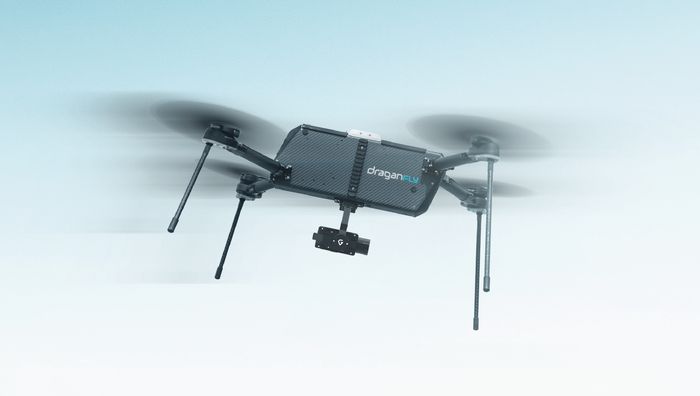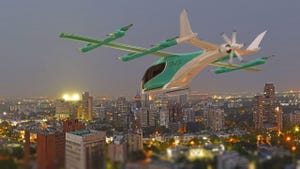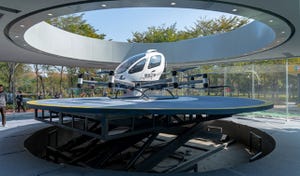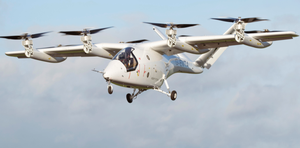Air Taxi Company Demonstrates Autonomous Flying for Air ForceAir Taxi Company Demonstrates Autonomous Flying for Air Force
In a dynamic operational environment, the self-flying Cessna moved among nine different locations
_(2).png?width=1280&auto=webp&quality=95&format=jpg&disable=upscale)
Flying taxi company Joby Aviation demonstrated autonomous logistic flying operations at the U.S. Air Force Agile 24-3 exercise.
For the exercise, Joby operated a fully autonomous Cessna 208B Grand Caravan plane for nearly 4,000 miles of flight between military bases across California and Nevada.
The Joby team included the autonomy division of Xwing, which Joby acquired earlier this year.
In what was described as a dynamic operational environment, the self-flying Cessna moved among nine different locations to restore the operational readiness for various Air Force assets.
The Cessna Caravan took off and landed autonomously at each location with no on-ground infrastructure.
“We were pleased to continue demonstrating the capabilities of our autonomy technology during Agile Flag 24-3, where we completed dozens of fully autonomous aerial missions and showcased an ability to perform rapid resupply,” said Maxime Gariel, autonomy lead at Joby. “We look forward to continuing to work with the U.S. Air Force as we further develop the suite of technologies that could enable greater automation or full autonomy, first on the Caravan and then on numerous other aircraft types.”
Xwing earlier this year participated in a similar exercise, completing nearly 3,000 miles of autonomous flights in congested airspace in night operations, sloped runways and at airports with no infrastructure.
Joby recently filed for its electric aerial vehicle (EAV) to be certified to be operated in Australia.
Joby also filed to have its certificate from the Federal Aviation Administration (FAA) validated by regulators at the Japan Civil Aviation Bureau and the United Kingdom’s Civil Aviation Authority once it receives it.
The Australia request follows a bilateral agreement between the FAA and Australia’s Civil Aviation Safety Authority (CASA).
Joby is at the third of five stages of the type certification process, which takes years and involves elaborate testing and documentation to meet stringent regulations.
The electric Joby flying taxi is designed to carry a pilot and four passengers and travel up to 200 mph. The company plans to operate its EAVs in New York City and Los Angeles along with its partner Delta Air Lines.
Joby, which has raised more than $2 billion from investors including Toyota, Delta Air Lines, SK Telecom and Uber, has logged more than 33,00 miles of all-electric flight with a full-scale prototype, according to the company.
Joby also has flown its eVTOL (electric vertical takeoff and landing) hydrogen-electric air taxi 523 miles in California in a pre-production, prototype battery-electric flying vehicle with a liquid hydrogen fuel tank and fuel cell system.
The EAV carried 88 pounds of liquid hydrogen and a reduced mass of batteries, which provided additional power for takeoff and landing.
The system, with hydrogen fed into a fuel cell system, was designed by H2FLY, a German subsidiary of Joby.
Joby recently received FAA approval to use its ElevateOS system, which includes a mobile-first rider app, pilot tools, operations and schedule management software and an intelligent matching engine.
Joby acquired the Uber Elevation air taxi division of Uber in 2021 and has been developing and testing the software tools since then.
Since the flying taxi is not yet approved for passenger carrying, Joby plans to use conventional aircraft that carry the same number of passengers as Joby’s to use the ride-hailing features.
Joby also has an exclusive agreement to provide flying taxi service in Dubai.
Archer Aviation, the other major air taxi company, has an agreement to collaborate on future autonomous flight with Wisk Aero. Boeing last year invested $450 million in Wisk and later acquired the startup, making it a Boeing subsidiary.
While Joby is partnered with Delta, Archer has a partnership with United Airlines.
EHang in China already is flying two-passenger, flying vehicles without onboard pilots.
A major advantage of the Xwing deal is the added relationships with the U.S. Department of Defense (DOD), since the U.S. military has been active in exploring the electric aerial revolution.
Joby has been working with the U.S. Air Force and delivered one of its eVTOL vehicles to MacDill Air Force Base in Tampa, Florida, following one delivered to Edwards Air Force Base in California last year.
Joby has a $163 million contract with the DOD AFWERX Agility Prime program and has been working with the DoD since 2016, when it received early military funding for its development program.
Like what you've just read? Stay up to date on the latest news about flying vehicles and other emerging technologies by signing up for our free daily newsletter >>>
Read more about:
Flying CarsAbout the Author
You May Also Like








